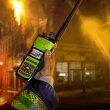Software-defined radio gets report card
Right now, there are about 750,000 radios in use by the combined branches of the U.S. military.
Many of these radios are old, and most aren't interoperable by military standards. This is why the Department of Defense has budgeted $6.8 billion to produce 180,000 software-defined radios, or SDRs, to start replacing the old units, at an average cost of $37,700.
Unfortunately, the promise of SDR technology — specifically radios whose bandwidths and modulation techniques are defined by easy-to-modify software rather than wired-in-place hardware — resulted in unrealistically high expectations for the DOD's Joint Tactical Radio System (JTRS), which went over budget and fell behind schedule. Consequently, the Pentagon redefined the JTRS program's goals on March 31, in an effort to get more SDRs into production.
Simplifying and prioritizing JTRS requirements makes sense to Mark Turner, a member of the SDR Forum Board of Directors and chairman of the group's SCA Working Group. The JTRS program created the software communications architecture (SCA) to ensure that SDRs manufactured by different vendors would be able to communicate with one another.
“The original JTRS program suffered from trying to do too much all at the same time,” Turner said. “The simplification has refocused its scope to something more achievable, developing capabilities in an incremental manner, targeted to meet the most pressing user needs first.”
However, simplifying the JTRS requirements probably won't speed the development of SDRs for public-safety, commercial and government users, said Allan Margulies, SDR Forum executive director. “The JTRS has no direct effect on the work of the [forum], nor on the development of SDRs for our members,” Margulies said.
Rick Taylor, M/A-COM's senior principal engineer, echoed Margulies' opinion.
“M/A-COM does not see JTRS as a significant influence for public-safety radio development,” Taylor said. “In fact, M/A-COM is already using — and will continue to use — the latest SDR technologies that make the most sense from cost versus functionality trade-offs that we re-evaluate for every new radio design. These trade-offs are driven by requirements for public safety that are not the same as those for JTRS, which causes the best radio solution for public safety to be different from that of JTRS.”
Even if the public-safety community did mimic JTRS technology, it might not matter. According to the forum's recently released research report, “Software Defined Radio Technology for Public Safety,” the military's SCA may not work for public-safety radios. The problem is that while the SCA standard is defined within a device, public-safety land mobile radio standards, such as the Association of Public-Safety Communications Officials Project 25 digital standard, historically have defined over-the-air interfaces or interfaces between radio system-level components.
Consequently, attempting to adopt an SCA-like standard for public-safety radios would require a dramatic change in how such radios are “developed, procured and regulated,” stated the report, which is available at www.sdrforum.org.
“The issue remains open as to whether such a standard [such as the JTRS SCA] would benefit public safety, and if so, the form that standard might take,” the report said.
While the Pentagon's JTRS project has slogged forward, the SDR Forum and its members have been making some progress toward SDRs over the last decade. For example, public-safety radios currently exist in the marketplace that meet the forum's Tier 2 designation, which requires the radio's software to control “a variety of modulation techniques, wideband or narrowband operation, communications security functions … and waveform requirements of current and evolving standards over a broad frequency range,” according to the report.
Still, this progress falls short of Tier 3, the forum's “ideal software radio,” one in which the radio's entire functionality can be programmed to support multiple bands and modulation platforms.
The report identifies several obstacles that must be cleared for Tier 3 radios to come to fruition. One concerns the question of whether an intra-device interface standard (IDIS) should be developed. An IDIS would standardize the components within an SDR regarding their relationship to each other.
This is important because the performance of an SDR relies on the radio's ability to change its operations by altering its software. If the components aren't linked in standardized relationships, software that successfully changes bandwidths on one manufacturer's radio may not do so on another vendor's handset.
The report also noted that the more capabilities an SDR offers, the more complicated it is to design and build. For example, the placement of the analog-to-digital and digital-to-analog converters is a delicate balancing act in the design of a public-safety portable radio.
Weight and size also are important issues. The more an SDR is designed to do, the bigger and heavier it becomes. Security is another challenge. SDRs will have to work with varying levels of network security and know their places in the hierarchy. However, they also will need to permit new users to connect to them during mutual-aid situations and allow incident commanders to override their authentication procedures if an emergency so demands.
Finally, price represents a major hurdle. Currently, the SDR Forum estimates the cost of a military-grade SDR at about $37,700. “Presently, SDRs cost more than most agencies can afford,” SDR Forum's Margulies said.
Looking forward, the SDR Forum's report offers many recommendations on the next steps needed to turn SDR from a dream into a reality (see graphic).
For instance, it recommends the development of cost models and business cases to identify benefits, lifecycle characteristics and procurement approaches for potential SDR buyers. It also recommends that the SDR Forum work more closely with other organizations — such as TIA ETSI, IEEE and APCO — to jointly develop SDR standards, and calls for radio manufacturers to develop SDR-based multi-protocol, multi-band and multi-service radios.
In addition, the report recommends that public-safety agencies find common ground with other radio users to develop a bigger market for SDRs, to help drive down handset costs, and suggests that the FCC develops new rules for multi-band, multi-service radios. However, even if each of these recommendations is fulfilled, the road toward public-safety SDR will be rough.
“In the United States, for example, more than 55,000 public-safety agencies operate communications systems that are based on disparate technologies, frequency bands and protocols,” the report stated. To make matter worse, “the public-safety community is composed of ‘late adopters’ — decision-makers who defer implementing a new technology until the level of uncertainty is low.”
PATH TO PUBLIC-SAFETY SDR
-
Recommend that radio/systems manufacturers expedite development of:
• SDR-based multi-protocol, multi-band and/or multi-service radios for public-safety applications.
-
Recommend that SDR software researchers investigate:
• feasibility of intra-device interface standards (IDIS).
-
Recommend that the public-safety community:
• explore capabilities common to LMR and other services to facilitate multi-service devices and develop a larger market for radio components that can support multiple markets.
-
Recommend that regulatory bodies modify existing relationships to support:
• rules that reflect use of multi-band radios, as well as multi-service radios.

















